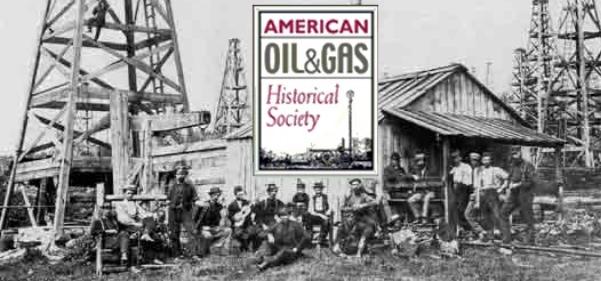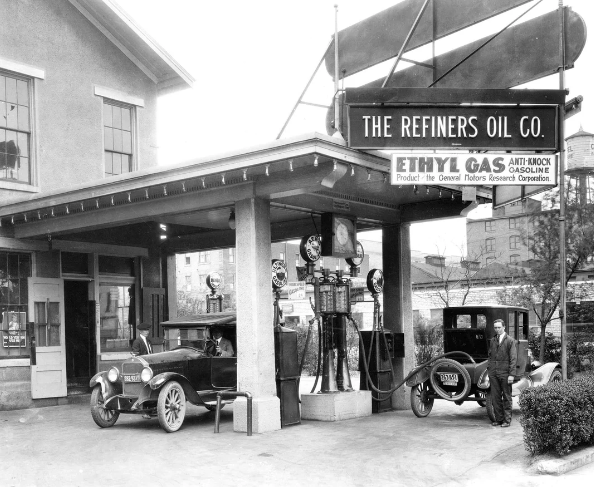Feb 20, 2025
Oil & Gas History News
Welcome to our latest review of U.S. petroleum industry milestones in exploration, production and transportation — and thanks for subscribing.
Bruce Wells

Oil & Gas History News, Vol. 6, No. 2
Articles begin with a 1902 machine shop in Lufkin, Texas; a giant oilfield discovery in California in 1910; Pennsylvania refiners protesting oil taxes in 1868; and an unusual Oklahoma well that erupted Vaseline-like oil in 1921. This month’s featured photo shows the Ohio gas station where tetra-ethyl lead was first sold in 1923. Our article links include the CIA history of the record-setting drillship Glomar Explorer; the first commercial Nevada oil well in 1954; and how two pipeline sections in 1993 became a Houston work of art. We conclude with some museum news and upcoming events. Thanks again for joining this unique oil patch history network.
This Week in Petroleum History Monthly Update
Links to summaries from four weeks of U.S. oil and natural gas history, including new technologies, oilfield discoveries, petroleum products, and pioneers.
February 17, 1902 – Lufkin Industries founded in East Texas
The Lufkin Foundry and Machine Company was founded in Lufkin, Texas, as a repair shop for railroad and sawmill machinery. When the East Texas pine region’s timber supplies began to dwindle, the company discovered oilfield service and production equipment opportunities in the burgeoning fields following the 1901 discovery at Spindletop Hill…MORE
February 10, 1910 – Giant Oilfield discovered in California
Honolulu Oil Corporation discovered the Buena Vista oilfield in Kern County, California. The well, originally known as “Honolulu’s Great Gasser,” drilled deep into oil-producing sands to produce 3,500 barrels of oil per day from depths approaching 4,000 feet. Steam injection operations helped the field produce…MORE
February 3, 1868 – Refiners seek End to Civil War Tax
Angry refiners from Oil Creek, Pennsylvania, met in Petroleum Center and passed a resolution demanding an end to the “war tax” of one dollar per 42-gallon barrel of refined petroleum products, including kerosene. During the Civil War, Treasury Secretary Salmon P. Chase advocated petroleum taxes…MORE
January 28, 1921 – “Vaseline Well” erupts in Oklahoma
After reaching a depth of 3,710 feet, drillers of the W.C. Newman well near Lamar, Oklahoma, “hit into a strata of oil, the like of which never before, nor since has been found,” reported the Daily Oklahoman in a 1933 retrospective of the well, which “caused oil men to marvel then, as today, since it produces the same Vaseline-like content.”…MORE
Energy Education

Anti-knock gasoline “Ethyl” with the additive tetraethyl lead went on sale for the first time in February 1923 at this Refiners Oil Company service station in Dayton, Ohio. Photo courtesy Kettering/GMI Alumni Foundation.
“Ethyl” Gasoline Additive debuts in 1923
The first anti-knock gasoline containing a tetraethyl lead compound went on sale on February 2, 1923, at the Refiners Oil Company service station in Dayton, Ohio. Invented by two General Motors scientists, “Ethyl” helped eliminate out-of-sequence detonations of the gasoline-air mixture in engine cylinders. GM initially gave stations bolt-on adapters called “Ethylizers” to meter proportions of the additive. “By the middle of this summer you will be able to purchase at approximately 30,000 filling stations in various parts of the country, a fluid that will double the efficiency of your automobile, eliminate the troublesome motor knock, and give you 100 percent greater mileage,” reported Popular
Science Monthly in 1924. High-octane leaded gasoline proved vital during World War II and continues to be used in aviation fuel. The additive was phased out for use in automobiles between 1976 and 1986.
Learn more in Ethyl Anti-Knock Gas.
Featured Articles
Spy Ship relaunched as Ultra-Deep Drill Ship
Decades after secretly recovering parts of a lost Soviet submarine and after a $180 million shipyard conversion, the Glomar Explorer began its career as a deep-water drill ship on January 30, 1998. The former CIA vessel Hughes Glomar Explorer spent the next 17 years setting records in deep waters around the globe. In 2006, the American Society of Mechanical Engineers designated the vessel a historic mechanical engineering landmark.
Learn more in Secret History of Drill Ship Glomar Explorer.
Oilfield finally discovered in Nevada
After decades of drilling hundreds of dry holes — the first drilled near Reno in 1907 — Nevada became a producing state on February 12, 1954. Shell Oil Company’s second test of its Eagle Springs No. 1 well produced oil from depths between 6,450 feet and 6,730 feet in Nye County. Eagle Springs was the state’s only oilfield for the next 22 years.
Learn more in First Nevada Oil Well.
Pipeline Saxophone debuts in Houston
With more than 2.5 million miles of oil and natural gas pipelines crisscrossing the United States, an offbeat Texas sculptor in 1993 repurposed about 70 feet to create a work of art. On February 20, 1993, Bob “Daddy-O” Wade debuted his blue “Smokesax” with 48-inch pipe sections at the opening gala of a Houston blues bar.
Learn more in “Smokesax” Art has Pipeline Heart.
News & Events
California History Collection — The Stanford University Libraries, the California Historical Society, and the Bill Lane Center for the American West announced on January 28 that Stanford would assume stewardship of more than 600,000 items spanning the history of the West since the 18th century.
Hermosa Beach Museum — The Drill’s Path: A Timeline of Oil Drilling in Hermosa Beach is a new, rotating exhibit at this Los Angeles County museum. Open from January 31 to March 31, the exhibit “traces the history of oil in Hermosa and the South Bay from the turn of the century to the present.”
Petroleum History Institute — The 23rd annual Oil History Symposium & Field Trip of the Petroleum History Institute (PHI) will take place from March 30 to April 1 in the Permian Basin of West Texas with an opening reception at the Odessa Marriott.
Youth Energy Awards — The National Energy Education Development (NEED) Project for 45 years has hosted a Youth Energy Conference & Awards in Washington, DC. Participating schools can submit digital portfolios of their activities by April each year.
Oklahoma Historical Society — The Oklahoma Historical Society (OHS) on March 20. 2025, will honor inductees to the Oklahoma Historians Hall of Fame during its annual awards banquet at the Oklahoma History Center in Oklahoma City.
Learn more in News & Events.
Thanks again for subscribing and for continuing to share our petroleum history articles and energy education research links. If you haven’t already, please consider supporting our work with a donation. Your contributions help the society’s ongoing work documenting, sharing and preserving the nation’s petroleum heritage for future generations.
— Bruce Wells
……………
Oil and gas history is important.
© 2025 American Oil & Gas Historical Society, 3204 18th Street NW, No. 3, Washington, DC 20010, United States, (202) 387-6996




